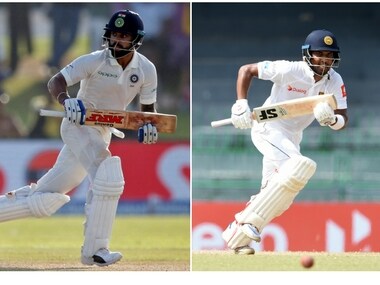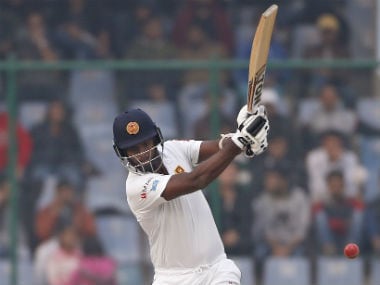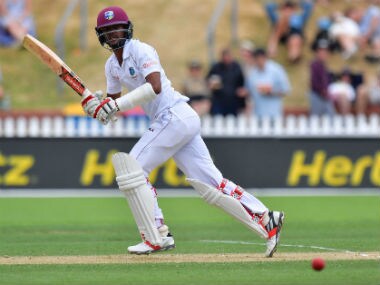India vs Sri Lanka: Butterfingers in slip cordon must bother hosts ahead of long overseas season
Identifying the right candidates to stand at slip should be, if not already, of utmost priority for Indians before they embark on the African safari.
Rohit Sankar, Dec, 04 2017
- West Indies in New Zealand, 2 Test Series, 2017 NZ Vs WI New Zealand beat West Indies by an innings and 67 runs
- Papua New Guinea and Scotland in UAE, 2 ODI Series, 2017 PNG Vs SCO Scotland beat Papua New Guinea by 4 wickets
- Papua New Guinea and Scotland in UAE, 2 ODI Series, 2017 PNG Vs SCO Scotland beat Papua New Guinea by 6 wickets
- Sri Lanka in India, 3 Test Series, 2017 IND Vs SL India beat Sri Lanka by an innings and 239 runs
- The Ashes, 2017/18 AUS Vs ENG Australia beat England by 10 wickets
- Afghanistan and Ireland in UAE, 3 ODI Series, 2017 AFG vs IRE - Dec 5th, 2017, 11:30 AM IST
- ICC World Cricket League Championship, 2015/17 HK vs PNG - Dec 6th, 2017, 11:30 AM IST
- Afghanistan and Ireland in UAE, 3 ODI Series, 2017 AFG vs IRE - Dec 7th, 2017, 11:30 AM IST
- ICC World Cricket League Championship, 2015/17 HK vs PNG - Dec 8th, 2017, 11:30 AM IST
- West Indies in New Zealand, 2 Test Series, 2017 NZ vs WI - Dec 9th, 2017, 03:30 AM IST
| Rank | Team | Points | Rating |
|---|---|---|---|
| 1 | India | 4493 | 125 |
| 2 | South Africa | 3767 | 111 |
| 3 | England | 4497 | 105 |
| 4 | New Zealand | 3114 | 97 |
| 5 | Australia | 3294 | 97 |
| Rank | Team | Points | Rating |
|---|---|---|---|
| 1 | South Africa | 6386 | 120 |
| 2 | India | 6379 | 120 |
| 3 | Australia | 5948 | 114 |
| 4 | England | 6156 | 114 |
| 5 | New Zealand | 5432 | 111 |
| Rank | Team | Points | Rating |
|---|---|---|---|
| 1 | Pakistan | 2843 | 124 |
| 2 | New Zealand | 1925 | 120 |
| 3 | West Indies | 2395 | 120 |
| 4 | England | 2029 | 119 |
| 5 | India | 2965 | 119 |





India vs Sri Lanka 1st Test, July 26-29, 2017, Galle
Having set a target of 550 to the hosts, India walked out confidently to bowl, knowing that their well-oiled bowling unit had cleaned up the hosts for 291 in the first innings. And then, the drama unfolded.
Mohammad Shami, who had done a fine job with the new ball once again ran in with purpose and eked out an outside edge off Upul Tharanga's bat.
India's captain Virat Kohli (L) drops a catch off Sri Lanka's Angelo Mathews during the third day of the second Test against Sri Lanka and India at the Sinhalese Sports Club (SSC) Ground in Colombo on 5 August, 2017. AFP
The ball flew to the slip cordon, where captain Virat Kohli, on the back of an unbeaten 103 in the first innings, stood at second slip. The ball went straight to him and as he clasped his palms around it, the cherry popped out, much to the dismay of the Indian fans. An enraged Kohli banged the ground in frustration but would have been relieved two balls later when Tharanga was cleaned up by Mohammad Shami.
Sri Lanka were eventually bowled out for 245 and India raced through to a 304-run win.
This has been the story of India's recent Test success. It isn't that India have been utterly flawless like a Vivian Richards' pull shot. It is just that their flaws in one department have been masked by an amalgamation of mediocrity from the opponents, and their own excellence in other departments.
Fielding in India was never quite as important as bowling or batting. It had always received a step-motherly treatment, and lousy Indian fielders on the edges of boundary were a common sight in the early 1990s. Barring some outstanding fielders, such as Ajay Jadeja and Mohammad Azharuddin, India had little to show for in the outfield.
The turnaround happened with the turn of the century when youngsters like Mohammad Kaif and Yuvraj Singh emerged, surprising Indian fans with their agility and spectacular catching. While a major corner was turned, India still hadn't matched the standards set in the field by the likes of South Africa, Australia and New Zealand.
The emphasis on fitness and fielding brought in a new generation of cricketers unafraid to throw themselves around and spectacular enough to hog the limelight with stunning catches.
The image of Dinesh Karthik flying at second slip in the quarter-finals against South Africa to hold onto a stunner in the inaugural T20 World Cup in 2007 lingers in the mind of most ardent Indian fans.
In Ravindra Jadeja, Virat Kohli, Ajinkya Rahane, Rohit Sharma and Shikhar Dhawan, India finally have a fielding unit to boast of. The ground fielding has, slowly but surely, reached exemplary levels. That there are fast bowlers in the side who can run out one of the fastest runners in cricket, AB de Villiers, shows the kind of levels India’s ground fielding had reached (The incident happened in the 2015 World Cup when Mohit Sharma ran out de Villiers to alter the course of the group match between the two teams).
***
India vs Sri Lanka 3rd Test, Dec 2-6, 2017, Delhi
India had declared under bizarre circumstances owing to smog in Delhi and Sri Lanka having a shortage of fit enough fielders. Furious with constant disruptions, Kohli opted to declare and put the visitors in to bat.
Mohammad Shami reposed the faith of his skipper with a wicket off the first ball of the innings and his new ball partner, Ishant Sharma, then sent back Dhananjaya de Silva.
And then drama unfolded, again.
Mohammad Shami found a bit of movement and had Dilruwan Perera edging to first slip. Shikhar Dhawan, the local boy, who was stationed at second slip, watched the ball all the way through and then suddenly decided to chase glory by going after a catch which first slip, in all likelihood, would have easily pouched. Needless to say, the Delhiiate made a complete mess of the catch and the ball even rolled away to hit the helmet, conceding five extra runs.
Two overs later, Ishant managed to eke out an outside edge off Angelo Mathews and the ball flew to the cordon. Virat Kohli, off the back of a double hundred, was stationed at second slip after Dhawan’s drop, but did nothing better as he put down a sitter to give Mathews a reprieve.
***
While a lot has been said and written about how India’s new generation of cricketers having mastered the art of fielding, slip catching remains a concern. Only a few months back, during the Sri Lankan tour, Kohli had emphasised on how India needed to work on their catching in the cordon.
“That is certainly an area that we want to keep improving in. It is a very tricky thing to figure out. Maybe we will have to figure out a certain distance that we just stay in, no matter if the ball falls in front of us or something like that. Specialists are always nice. I try to chip in but when I drop catches, it looks bad. We will have to figure out who stands in those positions consistently and keep those guys there for longer periods. I think that is the solution going forward”, Kohli had said then.
But seemingly, little has changed in the following two months. Kohli continues to drop catches, so does everyone else positioned in the cordon. India once had a time when slip catching was their sole plus point on the field. With men like Rahul Dravid, Mohammad Azharuddin and VVS Laxman manning the cordon, India had safe, reliable catchers, not butterfingers.
R. Sridhar, India’s fielding coach, had put across a rather smart idea last month when he stated the importance of simulating match situations in practice.
“The best thing is to try and create a match situation in practice. Especially, when you work with the angles, when you know certain fielders are going to field in certain areas. We try and create the same angles for them, so that you try cutting the angle as much as possible," he had said.
While Sridhar's methods have aided ground fielding and running between the wickets, the one area which they had no issues in, is suddenly becoming a huge point of concern.
Kohli himself has been a huge culprit in this regard. While the 143 runs he ran during his double hundred in Delhi on Day 2 emphasises the kind of fitness levels he has achieved, the training regime apparently has done little in terms of slip-catching.
The Indian skipper would remember how costly his drops have been in the recent past in overseas Tests. His drop of Brendon McCullum in New Zealand saw the swashbuckling batsman smash a triple hundred.
It is possibly time for India and Kohli to retrospect on their slip fielders. With testing overseas tours coming up, they sorely need right personnel in the cordon. Although most modern day captains, from Steven Smith to Jason Holder stand in the cordon, there is no hard and fast rule that Kohli has to be in a position he is evidently not so comfortable at.
Identifying the right candidates to stand at slip should be, if not already, of utmost priority for Indians before they embark on the African safari. In Lokesh Rahul and Cheteshwar Pujara, they have reliable close-in catchers and similar specialists in the cordon is the need of the hour.
Published Date:Dec 04, 2017
| Updated Date: Dec 04, 2017
Also See
India vs Sri Lanka: Virat Kohli's men aim to get back to winning ways in 'alien' conditions against confident visitors
India vs Sri Lanka: Hosts would look to score 650, before having a go at visitors for last few overs on Day 2
India vs Sri Lanka: Virat Kohli and Co well-placed to end successful home Test season with win against depleted visitors